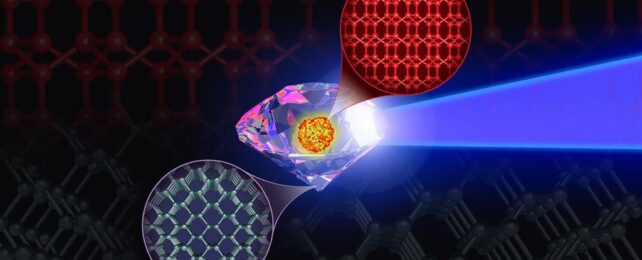ARTICLE AD
 An artist's impression of the synthesis of BC8 carbon, the so-called super-diamond. (Mark Meamber/LLNL)
An artist's impression of the synthesis of BC8 carbon, the so-called super-diamond. (Mark Meamber/LLNL)
Simulations of an elusive carbon molecule that leaves diamonds in the dust for hardness may pave the way to creating it in a lab.
Known as the eight-atom body-centered cubic (BC8) phase, the configuration is expected to be up to 30 percent more resistant to compression than diamond – the hardest known stable material on Earth.
Physicists from the US and Sweden ran quantum-accurate molecular-dynamics simulations on a supercomputer to see how diamond behaved under high pressure when temperatures rose to levels that ought to make it unstable, revealing new clues on the conditions that could push the carbon atoms in diamond into the unusual structure.
The BC8 phase has previously been observed here on Earth in two materials, silicon and germanium. Extrapolating the properties of BC8 seen in those materials has allowed scientists to determine how the phase would manifest in carbon.
Carbon's BC8 phase doesn't exist on Earth, though it is thought lurk out in the cosmos in the high-pressure environments deep inside exoplanets. Theory suggests it's the hardest form of carbon that can remain stable at pressures beyond 10 million times Earth's atmospheric pressure. If it could be synthesized and stabilized closer to home, it would open up some amazing research and material application possibilities.
Diamond is thought to be so hard because of its atomic structure. It's arranged in a tetrahedral lattice – each carbon atom within it is tetrahedrally linked to its four closest neighbors, matching the optimal configuration of the outermost electrons of the carbon atom itself.
"The BC8 structure maintains this perfect tetrahedral nearest-neighbor shape, but without the cleavage planes found in the diamond structure," says physicist Jon Eggert of the Lawrence Livermore National Laboratory. "The BC8 phase of carbon at ambient conditions would likely be much tougher than diamond."
However, although BC8 carbon should be able to exist in ambient conditions, attempts to synthesize it in a laboratory have come up short. Led by physicist Kien Nguyen Cong of the University of South Florida, a team of researchers harnessed the power of supercomputing to try to find out where those attempts were going wrong.
The Frontier supercomputer at Oak Ridge National Laboratory is currently the fastest supercomputer in the world. Using this incredible piece of hardware, the team developed a simulation that describes interactions between individual atoms within a very high range of pressure and temperature conditions. Running this simulation on Frontier, they were able to reproduce the evolution of billions of carbon atoms under extreme conditions.
The results revealed the reason why synthesis of BC8 carbon has been so difficult to achieve.
"We predicted," explains physicist Ivan Olyenik of the University of South Florida, "that the post-diamond BC8 phase would be experimentally accessible only within a narrow high-pressure, high-temperature region of the carbon phase diagram."
In other words, there's only a very small high-pressure and -temperature region in which BC8 carbon can form, and so far experiments have not met those conditions. On the other hand, though, now that we know what those conditions are, the synthesis of BC8 carbon might finally be achievable.
The researchers are currently engaged in theory-inspired experiments at the National Ignition Facility to do just that… so watch this space.
The findings have been published in The Journal of Physical Chemistry Letters.

 9 months ago
67
9 months ago
67 

